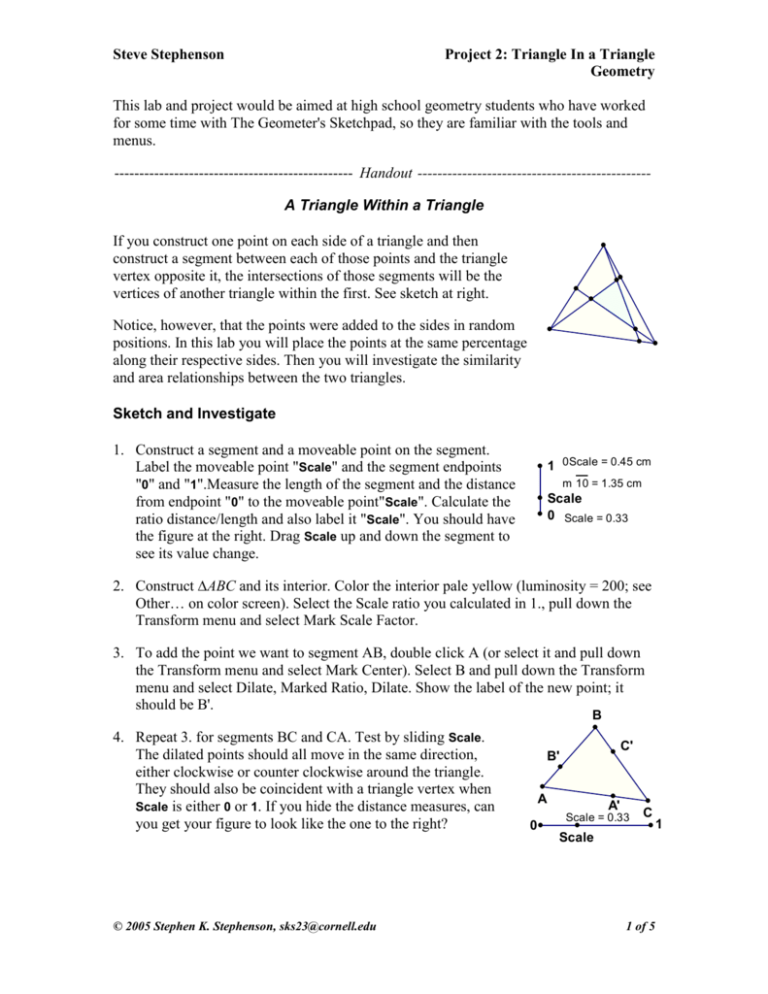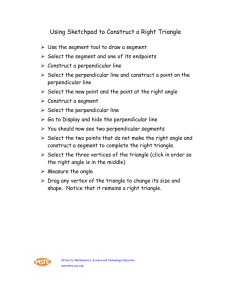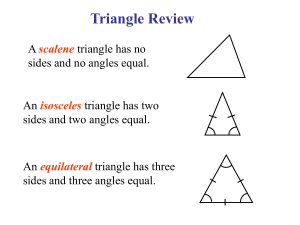
Steve Stephenson
Project 2: Triangle In a Triangle
Geometry
This lab and project would be aimed at high school geometry students who have worked
for some time with The Geometer's Sketchpad, so they are familiar with the tools and
menus.
------------------------------------------------ Handout ----------------------------------------------A Triangle Within a Triangle
If you construct one point on each side of a triangle and then
construct a segment between each of those points and the triangle
vertex opposite it, the intersections of those segments will be the
vertices of another triangle within the first. See sketch at right.
Notice, however, that the points were added to the sides in random
positions. In this lab you will place the points at the same percentage
along their respective sides. Then you will investigate the similarity
and area relationships between the two triangles.
Sketch and Investigate
1. Construct a segment and a moveable point on the segment.
Label the moveable point "Scale" and the segment endpoints
"0" and "1".Measure the length of the segment and the distance
from endpoint "0" to the moveable point"Scale". Calculate the
ratio distance/length and also label it "Scale". You should have
the figure at the right. Drag Scale up and down the segment to
see its value change.
1 0Scale = 0.45 cm
m 10 = 1.35 cm
Scale
0 Scale = 0.33
2. Construct ∆ABC and its interior. Color the interior pale yellow (luminosity = 200; see
Other… on color screen). Select the Scale ratio you calculated in 1., pull down the
Transform menu and select Mark Scale Factor.
3. To add the point we want to segment AB, double click A (or select it and pull down
the Transform menu and select Mark Center). Select B and pull down the Transform
menu and select Dilate, Marked Ratio, Dilate. Show the label of the new point; it
should be B'.
B
4. Repeat 3. for segments BC and CA. Test by sliding Scale.
The dilated points should all move in the same direction,
either clockwise or counter clockwise around the triangle.
They should also be coincident with a triangle vertex when
Scale is either 0 or 1. If you hide the distance measures, can
you get your figure to look like the one to the right?
C'
B'
A
0
A'
Scale = 0.33
C
Scale
© 2005 Stephen K. Stephenson, sks23@cornell.edu
1 of 5
1
Steve Stephenson
Project 2: Triangle In a Triangle
Geometry
5. Construct segments AC', BA', and CB' and their intersection
points. Label the intersection points D, E, and F. Construct
interior of ∆DEF and color it pale blue (luminosity = 200).
Why does the interior show up as green? See figure at right.
B
B'
E
C'
D
F
6. Slide the Scale back and forth while watching the triangles.
A
A'
Are they ever similar? Now move one or two of ∆ABC's
Scale = 0.33 C
1
0
vertices. Are the two triangles ever similar now? To really
Scale
answer this question we need to compare angle measures.
The triangles are similar if corresponding angle measures are equal. So measure the
six angles. Since it would be easier to see if differences are zero, rather than angles
are equal, calculate the nine differences. Now vary Scale and vertices positions and
see if the triangles are similar; are they?
B
B'
C'
E
D
F
A
0
A'
Scale = 0.33
C
1
mÐCAB = 55.9946°
mÐCAB-mÐFDE = 8.5422°
mÐBCA-mÐFDE = -0.7570°
mÐABC = 77.3099°
mÐCAB-mÐDEF = -21.9890° mÐBCA-mÐDEF = -31.2881°
mÐBCA = 46.6954°
mÐCAB-mÐEFD = 1.4306°
mÐFDE = 47.4524°
mÐABC-mÐFDE = 29.8575°
mÐDEF = 77.9836°
mÐABC-mÐDEF = -0.6736°
mÐEFD = 54.5640°
mÐABC-mÐEFD = 22.7459°
mÐBCA-mÐEFD = -7.8686°
Scale
7. Before measuring areas, try to form a conjecture about how the two triangles areas
might be related. If you were to divide the area of the small triangle by the area of the
large and graph that ratio, what would be the general shape of the curve? What would
be happening at Scale values of 0 and 1? What about halfway between?
8. Measure the area of the small and large
triangles' interiors. Calculate the ratio of
small area to large. As you move the
Scale back and forth can you see any
patterns in the area ratio? Would it help
to graph the data?
B
B'
C'
E
D
F
A
A'
Scale = 0.33
Area
DEF = 0.39 cm 2
Area
ABC = 2.76 cm 2
(Area
DEF)
(Area
ABC)
= 0.14
C
1
0
9. We can use the Scale segment for our
Scale
horizontal axis for graphing, but we
need a perpendicular axis at Scale = 0.
Mark the point 0 as a Center by double clicking it. Select segment 01 and point 1, pull
down the Transform menu, select Rotate, type +90°, and click Rotate. Label the
endpoint of the new segment R, short for Ratio. We have a coordinate system.
© 2005 Stephen K. Stephenson, sks23@cornell.edu
2 of 5
Steve Stephenson
Project 2: Triangle In a Triangle
Geometry
M
10. Double click R to mark it as the center
R
of rotation, select segment 0R, Rotate
B
+90°. Change new segment to dashed.
C'
E
Construct a perpendicular to segment
B'
D
01 at Scale. Construct the point of
F
intersection of this new line with the
A
A'
dashed segment above, label it M (for
Scale = 0.33 C
maximum). Does your figure look like 0
1
Scale
the one to the right?
Area
DEF = 0.39 cm 2
Area
ABC = 2.76 cm 2
(Area
DEF)
(Area
ABC)
(Area
DEF)
(Area
ABC )
= 0.14
= 0.14
M
R
B
B'
C'
E
D
F
A
0
A'
Scale = 0.33
C
1
Scale
(Area
DEF)
= 0.14
11. Hide the line and the two triangle area measures. Select the
(Area ABC )
M
area ratio calculation, pull down the Transform menu, and
R
B
select Mark Scale Factor. Double click Scale to mark it as a
dilation center. Select M, pull down the Transform menu,
C'
select Dilate, Marked Ratio, and Dilate. Select the new point
E
B'
D
and the point Scale, then Construct Locus. Select the new
F
locus and change it to Display as a thin blue line. Does your
A
figure look like the one to the right?
A'
12. Do you think the locus fairly represents the area ratio? Is it
compatible with your conjecture in 7 above? What might the
equation be for the locus?
(Area
DEF)
(Area
ABC )
= 0.14
M
R
B
B'
C'
E
D
F
A
A'
Scale = 0.33
0
C
1
Scale H
H' Scale'
H'
0'
Area H0'H'0 = 2.78 cm 2
0
Scale = 0.33
C
1
Scale H
H'
0'
13. On the same coordinate system,
Area H0'H'0 = 2.78 cm 2
let's plot a parabola to compare
it with the locus we have. Construct the midpoint of
segment 01. Rotate point 0 about that midpoint +90°,
then rotate the midpoint about the new point +90°. Point
0, the midpoint of segment 01, and the two new rotated
points are vertices of a square; construct its interior and
measure its area. Does your figure look like the one to
the right?
14. Now construct another square just like in 13, but this
time use the point Scale and the midpoint of segment 01
as the first two vertices. Does your figure look like the
one to the left?
Area H'Scale'HScale = 0.31 cm 2
© 2005 Stephen K. Stephenson, sks23@cornell.edu
3 of 5
Steve Stephenson
Project 2: Triangle In a Triangle
Geometry
15. Calculate the ratio of small square area to large and Mark it
M
R
as the Scale Factor in the Transform menu. Double click
B
point Scale to mark it as a dilation center, select point M
C'
and Dilate it by the Scale Factor. Select the new point and
B' D E
the point Scale, and Construct Locus. Change the locus to a
F
thin red line. After hiding or relabeling a few things, could
your figure look like the one to the right?
A
A'
C
0
16. So is the locus of the ratio of the triangular areas a
parabola?
1
Scale
Scale = 0.33
(Area DEF)
= 0.16
(Area ABC)
Explore More
Try to extend this analysis to a quadrilateral. Would you have
one or two diagonals for each vertex?
Ratio of Square Areas = 0.12
-------------------------------------------- End of Handout -----------------------------------------Teacher's Resources
The Sketchpad file, http://home.comcast.net/%7Esks23cu/sketches/3gonIn3gon.gsp,
contains the constructions above (pages 1-11 in the file) and these three constructions:
© 2005 Stephen K. Stephenson, sks23@cornell.edu. All rights reserved.
A Triangle Within a Triangle
Area Ratio
Show Locus
(Area
Hide
(Area
B
DEF)
ABC)
Show Parabola
= 0.1448
Area Ratio is NOT
1 2
f(x) = 4 x2
C'
( )
mÐCAB = 52.16°
mÐABC = 56.06°
mÐFDE = 58.39°
mÐBCA = 71.78°
mÐEFD = 70.80°
mÐDEF = 50.81°
mÐCAB-mÐFDE = -6.23699°
mÐCAB-mÐDEF = 1.35214°
E
mÐCAB-mÐEFD = -18.6413°
mÐABC-mÐFDE = -2.33769°
mÐABC-mÐDEF = 5.25144°
B'
mÐABC-mÐEFD = -14.74199°
F
D
mÐBCA-mÐFDE = 13.38985°
C
mÐBCA-mÐDEF = 20.97898°
A'
A
Area Ratio
mÐBCA-mÐEFD = 0.98555°
Scale = 0.3321
Show Construction
Animate
0
Scale
(Red Area)
1
The triangles are never similar,
except at scales of 0 and 1 they
are congruent.
= 0.11
(Grey Area)
Red Area = 1.97 cm 2
Grey Area = 17.48 cm 2
© 2005 Stephen K. Stephenson, sks23@cornell.edu
4 of 5
Steve Stephenson
Project 2: Triangle In a Triangle
Geometry
© 2005 Stephen K. Stephenson, sks23@cornell.edu. All rights reserved.
Quadrilateral in Quadrilateral, 1 diagonal/point
Area Ratio
Show Locus
(Area EFGH)
Hide
(Area ABCD)
Show Parabola
= 0.08
It's NOT g(x) = x2
C
B
F
E
G
H
A
D
Scale = 0.3331
Area Ratio
Animate
0
1
Scale
(Area red square)
(Area purple square)
= 0.11
© 2005 Stephen K. Stephenson, sks23@cornell.edu. All rights reserved.
Quadrilateral in Quadrilateral, 2 diagonals/point
Area Ratio?
B
C
A
Animate
0
D
Scale = 0.5018
1
Scale
How can we graph area of grey region? It's the
intersection of the green and red interiors.
(Set scale to 0.502 to see the problem.)
© 2005 Stephen K. Stephenson, sks23@cornell.edu
5 of 5







